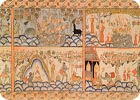‘Sharp’ Blade Protects Museum

Who would have figured that a museum honoring centuries old scrolls and block prints would be at the leading edge of blade servers dedicated to security video? But the Asian Art Museum of San Francisco knows the advantages of a sharp blade.
The institution is working with Avnet, DataCom, Blade Network Technologies and IBM to tightened security around its world-renowned collection of more than 16,000 Asian artworks by installing a DVD-quality video surveillance system based on IBM BladeCenter servers, IP-based software from DataCom and Ethernet network switches from Blade Network Technologies. The solution will help the museum view, monitor and digitally record activity while archiving footage over an IP network.
COST SAVINGS
The Asian Art Museum is home to the largest collection of Asian art in the United States, valued at $4 billion dollars. After a five year, $165+ million dollar reconstruction project, the museum received a grant to bolster its security system last October. It began investigating ways to supplement its analog camera-to-VCR network. Replacing the 130 cameras with sophisticated video technology could cost upwards of half a million dollars, but DataCom’s security networks running on the IBM BladeCenter platform leveraged existing analog sources and network components without adding new equipment.
“The solution from Avnet, DataCom, Blade and IBM provided a one stop call in terms of service,” said Jim Horio, director of information technology at the Asian Art Museum. “Not only was the solution up and running in a matter of weeks but the scalability of the IBM BladeCenter will allow us to increase the system’s capacity if and when we need to.”
The network video servers (NVS) form the central component of advanced security networks. Each NVS records and displays high-quality, real-time video with an easy to operate interface allowing security personnel to access and manage an unlimited number of servers and cameras through local, remote or Web access. Because the solution compresses images on a 64-bit video capture board, it frees more than 80 percent of BladeCenter system resources for enterprise applications. The BladeCenter is equipped with Blade’s Nortel Layer 2/3 Gigabit Ethernet Switch Modules to provide needed bandwidth, speed and security to pass multiple video feeds into the storage network and to coordinate network interaction from the operators.
VM Assist, an IT professional consulting and services company and Avnet IBM partner, implemented the solution at the Asian Art Museum.
SIDEBAR: What Is a Blade Server?
Blade servers are self-contained computer servers, designed for high density. While a standard rack-mount server can exist with (at least) a power cord and network cable, blade servers have many components removed for space, power and other considerations while still having all the functional components to be considered a computer. A blade enclosure provides services such as power, cooling, networking, various interconnects and management. Different blade providers have differing principles around what should and should not be included in the blade itself (and sometimes in the enclosure altogether). Together these form the blade system.
Looking for a reprint of this article?
From high-res PDFs to custom plaques, order your copy today!




